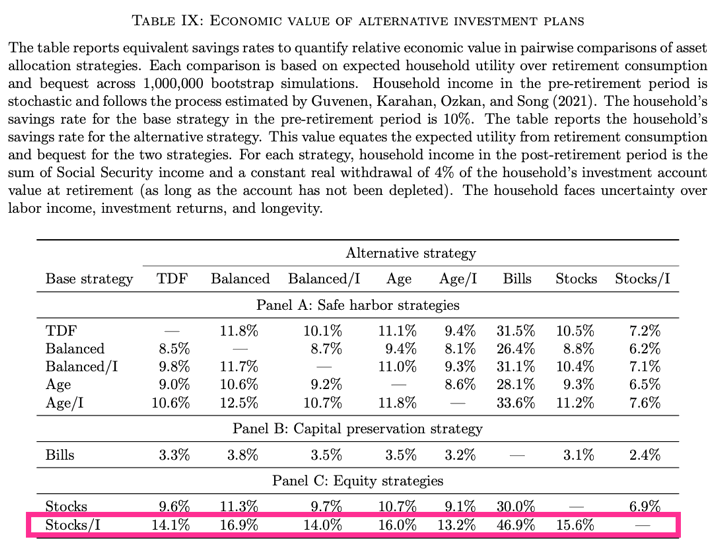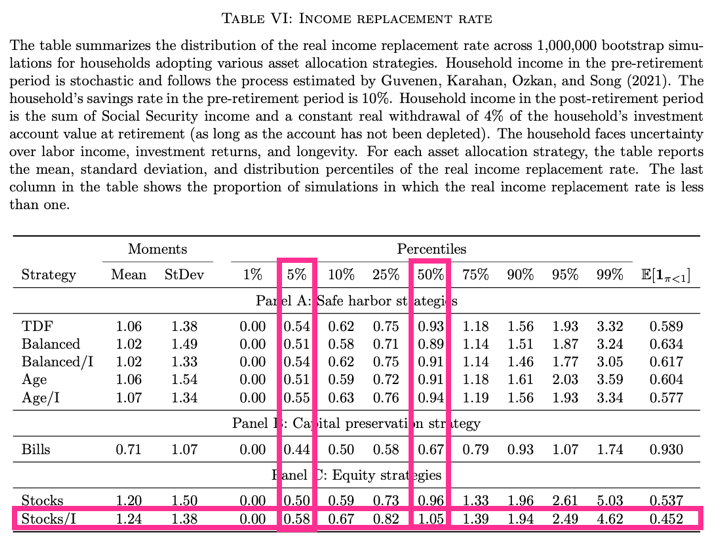The academic paper Beyond the Status Quo: A Critical Assessment of Lifecycle Investment Advice by Anarkulova, Cederburg and O’Doherty had a conclusion that caught my eye. From the abstract:
We challenge two central tenets of lifecycle investing: (i) investors should diversify across stocks and bonds and (ii) the young should hold more stocks than the old. An even mix of 50% domestic stocks and 50% international stocks held throughout one’s lifetime vastly outperforms age-based, stock-bond strategies in building wealth, supporting retirement consumption, preserving capital, and generating bequests.
Now, the actual paper was not written for non-academics and there was very slim pickins’ in the “easy-to-understand graphic that summarizes our results” department, but I’ll try my best. They studied 8 different portfolios, summarized below. (They also picked the names.)
- TDF. Follows the asset allocation of the most popular target-date funds, which use a glide path that starts at 90% equities but reduces equity percentage over time.
- Balanced. 60% US stocks, 40% bonds.
- Balanced/I. 30% US stocks, 30% International stocks, 40% bonds.
- Age. (120-Age)% US stocks, (Age-20)% bonds.
- Age/I. (60-Age/2)% US stocks, (60-Age/2)% International stocks, (Age-20)% bonds.
- Bills. Invests only in Treasury bills.
- Stocks. 100% US stocks.
- Stocks/I. 50% US stocks, 50% International stocks.
In the chart below, the authors show the equivalent savings rate that would have been required to reach the same level of “expected utility of retirement consumption” (retirement income provided + leftover money at death) throughout the entire lifecycle of a 10% savings rate during the working years and then spending it down at a 4% withdrawal rate in retirement.

Let’s look at the highlighted pink box. This is the line for the best performing portfolio of 50% US stocks, 50% International stocks (“Stocks/I”). In order to have gotten the same amount of retirement income + bequest as a 10% savings rate with Stocks/I, you would have had to save 14.1% with a TDF, 16.9% with the Balanced portfolio, and so on. Note that staying in cash “bills”, you would need to ratchet up to 47% savings rate!
In another chart, we see that 50% US stocks, 50% International stocks (“Stocks/I”) also creates the highest income replacement rate in retirement, based on a 10% savings rate. This is true on average (50% percentile) and even in the worst-case scenarios (5th percentile), as long as you stayed with the plan. The drawdowns would have been temporarily more severe over certain periods of time, however.

My takeaways are:
- You might consider a 100% stock portfolio with international exposure, if you really have the stomach for it. I’d probably recommend waiting until after you have survived a 50% crash first. Optimally, your portfolio would grow so much that by retirement, you may not even need a 4% withdrawal rate.
- All of the other portfolios that contains some bonds (TDF, Balanced, Balanced/I, Age, Age/I) had very similar results over the entire lifecycle of accumulation and spending down. They still did pretty well.
- Everyone should definitely own a good chunk of stocks, as trying to accumulate enough money with just safe “cash” in the form of Treasury bills or bank accounts is going to require in the neighborhood of five times the savings rate.
 The Best Credit Card Bonus Offers – July 2024
The Best Credit Card Bonus Offers – July 2024 Big List of Free Stocks from Brokerage Apps
Big List of Free Stocks from Brokerage Apps Best Interest Rates on Cash - July 2024
Best Interest Rates on Cash - July 2024 Free Credit Scores x 3 + Free Credit Monitoring
Free Credit Scores x 3 + Free Credit Monitoring Best No Fee 0% APR Balance Transfer Offers
Best No Fee 0% APR Balance Transfer Offers Little-Known Cellular Data Plans That Can Save Big Money
Little-Known Cellular Data Plans That Can Save Big Money How To Haggle Your Cable or Direct TV Bill
How To Haggle Your Cable or Direct TV Bill Big List of Free Consumer Data Reports (Credit, Rent, Work)
Big List of Free Consumer Data Reports (Credit, Rent, Work)
ERN did a more critical assessment of the paper. https://earlyretirementnow.com/2024/02/12/100-percent-stocks-for-the-long-run/
For anyone nearing retirement, owning that much stocks is a recipe for failure. When something like the next pandemic hits, and you see your retirement funds head toward a 50-75% loss within weeks, you HAVE to sell, unless you want to risk sleeping under a bridge in old age and working as a Walmart greeter at age 80. So you will lose your shirt in a crash. You’re far better off putting a bunch of money (especially IRA/401K tax-deferred money) into 25-year TIPS, which yield inflation+2.2% at the moment. There’s no risk, and you still get a decent return, with complete inflation protection. And if TIPS goes back to the levels it was at a couple years ago, you can almost double your money by selling them at that point (2050 TIPS are discounted almost 50% because of the low coupon rate). If they don’t, you hold them to maturity, risk-free.
I retired at 57 in 2012 with about $900K and have always been fully invested in U.S Stocks. I’m now 70 and have about 4 million. I stay away from foreign stocks because 1) currency translations, 2) arcane tax rules, & 3) major U.S. corporations are international in nature.
Good luck to all on their investments!
I suspect if you have a lot of money, enough that you can ride out the crashes, then this is a good approach to maximizing generational wealth. If you have a more normal level of savings, where losing 30-40% plus in a year and staying down 2-3 years would mean you end up shaving down the nest egg a lot, you might be better off with a more conservative approach.
I agree, if you have a stable job, high income, sturdy pension, or spouse/partner with these things, all that helps you shrug off those market wobbles.